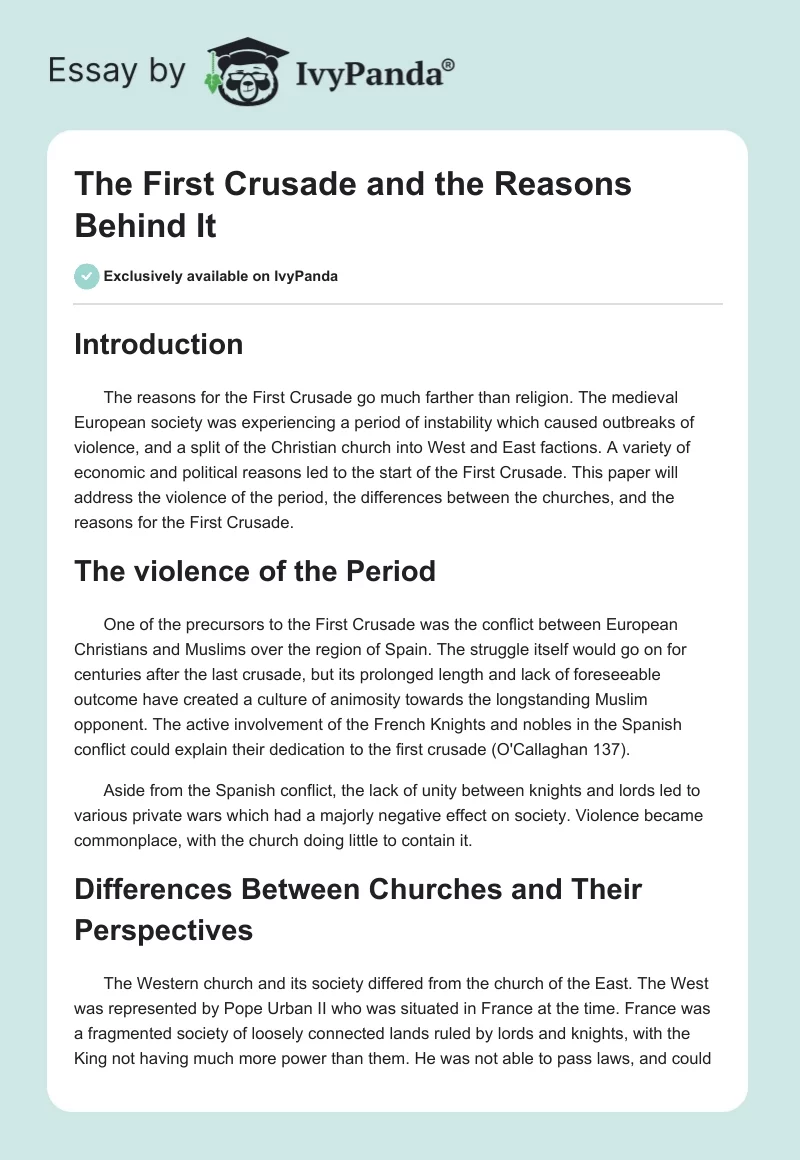Introduction
The reasons for the First Crusade go much farther than religion. The medieval European society was experiencing a period of instability which caused outbreaks of violence, and a split of the Christian church into West and East factions. A variety of economic and political reasons led to the start of the First Crusade. This paper will address the violence of the period, the differences between the churches, and the reasons for the First Crusade.
The violence of the Period
One of the precursors to the First Crusade was the conflict between European Christians and Muslims over the region of Spain. The struggle itself would go on for centuries after the last crusade, but its prolonged length and lack of foreseeable outcome have created a culture of animosity towards the longstanding Muslim opponent. The active involvement of the French Knights and nobles in the Spanish conflict could explain their dedication to the first crusade (O’Callaghan 137).
Aside from the Spanish conflict, the lack of unity between knights and lords led to various private wars which had a majorly negative effect on society. Violence became commonplace, with the church doing little to contain it.
Differences Between Churches and Their Perspectives
The Western church and its society differed from the church of the East. The West was represented by Pope Urban II who was situated in France at the time. France was a fragmented society of loosely connected lands ruled by lords and knights, with the King not having much more power than them. He was not able to pass laws, and could not have a great effect on the country. The hierarchical system of feudalism was governing the regions with oaths being used to conduct political activities. Peasants had the least power and often were not considered free people (Bloch 311).
For Pope Urban II, the First Crusade had to happen for a number of reasons. The religious zeal caused by the destruction of the Church of the Holy Sepulchre could be exploited to gather a large army. Political and economic opportunity of having positive relations with the Eastern Church of Byzantine was another factor. Despite the Byzantine Empire instating their own Pope, a plea for help from the area was seen as an opportunity to create a politically fruitful relationship, as well as possibly unite the churches (Tyerman 243).
The initial goal of the official crusade was to push back the Seljuk Turks from the Holy Land. With time, however, the goal changed to retaking Jerusalem as it would make the Crusade a religious pilgrimage and would focus the forces on one historically and religiously significant goal (Spencer 57).
The Byzantine Empire had a different society than Europe. The society was a combination of Christian, Islamic, and Jewish cultures, with a stable governmental leader and religious people following patriarchs instead of the Pope. Even during a downturn in its history, the Byzantine Empire was famous for its scientific advancement, high artistry, as well as economic and intellectual level.
However, the Byzantine Empire was slowly losing its land to the Muslim armies, and the Emperor was had to call for help from the European Christians. His perspective was largely motivated by the goal of returning the lands he previously lost, which can be seen in his insistence on having the European leaders of the armies to take an oath that was supposed to guarantee this. Therefore the First Crusade was seen as a solution for domestic problems of both Churches. The Pope wanted Byzantine as a political ally and to unite the fragmented society under one goal. The Byzantine Emperor sought the return of the lands he lost to Muslims, and the European Nobles thought they could capitalize on the war by capturing the lands for themselves (Kaldellis 353).
Peasants’ Crusade
The pope used the violent culture of medieval Europe as well as its religious zeal to rally a large army and set a date by which they must start the Crusade. Unfortunately, the call for the crusade was not only taken up by nobles but also peasants from various regions of Europe. People led by such leaders as Peter, the Hermit, and Walter Sans-Avoir, amassed large groups of peasants with an aim to retake Jerusalem because they saw it as the heavenly Jerusalem of the Bible (Nicolle 64).
These groups were terribly mismanaged and lacked strong leadership. This “Peasants’ Crusade’ led to thousands of dead civilians from pillaging that occurred throughout the journey and anti-Semitic actions of the peasant group from the Rhineland. Mass persecutions of Jews were committed by this group, leading to thousands of dead, and whole cities ransacked (Cohen 31).
Conclusion
The reasons and events that led to the First Crusade are numerous. The fragmentation of Western Europe and the loss of land by the Byzantine created the conditions that allowed for the Crusade to happen. However, the violent society of western Europe led to the Crusade causing thousands of civilian deaths, through both the Peasant crusade and the Prices’ Crusade.
Works Cited
Cohen, Jeremy. Sanctifying the Name of God: Jewish Martyrs and Jewish Memories of the First Crusade. University Of Pennsylvania Press, 2013.
Kaldellis, Anthony. Streams of Gold, Rivers of Blood: The Rise and Fall of Byzantium, 955 A.D. to the First Crusade. Oxford University Press, 2017.
Bloch, Marc. Feudal Society. Taylor and Francis, 2014.
Tyerman, Christopher. How to Plan a Crusade. Penguin Books, 2015.
Spencer, Stephen J. “The Emotional Rhetoric of Crusader Spirituality in the Narratives of the First Crusade.” Nottingham Medieval Studies, vol. 58, 2014, pp. 57-86.
Nicolle, David. The Crusades. Bloomsbury Publishing, 2014.
O’Callaghan, Joseph F. A History of Medieval Spain. Cornell University Press, 2013.


